
Austria’s Only Travel Guide You Need For A Great Trip in 11 Easy Steps
- Destinations Europe
Cruisit Team
- May 4, 2022
- 0
- 4617
- 81 minutes read
Austria’s Background
Austria, formerly the center of power for the vast Austro-Hungarian Empire, was reduced to a tiny republic following its loss in World War I. Austria’s position was uncertain for a decade after Nazi Germany’s takeover in 1938 and subsequent occupation by the victorious Allies in 1945. The signing of the State Treaty in 1955 ended the occupation, acknowledged Austria’s independence, and prohibited merger with Germany. The same year, a constitutional amendment mandated the country’s “perpetual neutrality” as a condition for Soviet military withdrawal. Following the disintegration of the Soviet Union in 1991 and Austria’s accession to the European Union in 1995, numerous Austrians questioned the country’s neutrality. Austria, an affluent and democratic country, joined the Economic and Monetary Union in 1999.
In this Alpine nation, the force is strong with a melody. Under the Habsburg monarchy, this Edelweiss nation reigned over a huge area of Central and Eastern Europe. All of this came to an end after World War I, when the Austro-Hungarian double monarchy was abolished and the country was divided into various successor states.
With its majestic palaces, stately buildings, and broad avenues, Vienna still reminds visitors of its previous Imperial splendor. Empress Sisi’s ongoing popularity assures a continuing interest in all things ‘Kaiserlich’ (Imperial). And Mozart, the world’s first rock star, will add some waltz to your steps as you dance around the streets of Salzburg.
No other nation swings so seamlessly between the urban and the natural worlds as Austria. The next thing you know, you’re swanning about imperial Vienna, cresting mountain peaks.
“From historically resonant imperial Vienna to cresting mountain peaks of the Alps, Austria offers a ton.“
There is enough to do with Tirol in the west, the Danube in the east, and Styria in the south. Ski the Alps, take a boat ride down the Danube, attend a classical concert in Salzburg, stroll through the Schönbrunn Palace parks, savor wine in traditional wine taverns in Styria, eat goulash or Wiener Schnitzel in a cozy restaurant, and have a coffee and a ‘Sacher-torte’ in a Viennese coffee house.
Austria is a country known for its culture and hiking, dancing and music, skiing and après-skiing, and drinking and dining. And if it all seems too much for you, gaze at the flowers!
Austrian prices are comparable to those found everywhere in Western Europe, however, they are slightly more than those found in the United States. Consider making a couple of your meals and going out less often to save money. Restaurants may be rather pricey, especially around supper hours. Consider visiting Austria during the shoulder season as well.
Prices rise during the winter months when people go to the Alps to ski. They’re also higher during the summer when many families come to visit. The finest prices are likely to be found during the spring or fall months when visitor crowds are at their lowest and demand is at its lowest.
- Walk around Vienna, known as Wien, the former Imperial capital has more than enough to see and do, visit Schönbrunn, The Belvedere, Hofburg, go over to the Opera or take riding lessons at the world-renowned Spanish Riding School, and also don’t forget to bring on your dancing shoes for one of 200 or so balls that are held each year.
- Skiing in Tyrol, Sankt Anton (also known as Sankt Anton am Arlberg), Lech (also known as Lech am Arlberg), or anywhere else is a fantastic alternative.
- Visit Mozart’s birthplace, Salzburg, and ascend to the imposing Hohensalzburg Castle for stunning vistas. Stroll around the historic town of Innsbruck, which hosted the Winter Olympics.
- Walk around Vienna, known as Wien, the former Imperial capital has more than enough to see and do, visit Schönbrunn, The Belvedere, Hofburg, go over to the Opera or take riding lessons at the world-renowned Spanish Riding School, and also don’t forget to bring on your dancing shoes for one of 200 or so balls that are held each year.
- Skiing in Tyrol, Sankt Anton (also known as Sankt Anton am Arlberg), Lech (also known as Lech am Arlberg), or anywhere else is a fantastic alternative.
- Visit Mozart’s birthplace, Salzburg, and ascend to the imposing Hohensalzburg Castle for stunning vistas. Stroll around the historic town of Innsbruck, which hosted the Winter Olympics.
- Ride a boat along the Danube or cycle along its banks.
- Pretend you’re in the Salzkammergut Region, a country of lakes, lush hills, mountains, and beautiful villages.
- Drive through the Wachau Valley, with its vineyards, charming towns, the Danube, and the majestic Melk Abbey at Melk.
- After a long day of trekking in the Hohe Tauern National Park, unwind in the hot springs of Bad Gastein.
- Canoe across the Wörthersee (also known as Lake Wörth) or go cave spelunking in the adjacent caverns.
- Take a stroll around Graz’s World Heritage-listed Altstadt.
- Austria charges a toll on its highways and requires a vignette sticker on its roadways.
- The New Year’s Concert in Vienna is world-famous and notoriously difficult to obtain tickets for; plan ahead of time if you want to attend!
- German is the official language, while Austrian German, Hungarian, and Slovenian are also spoken, however English is prevalent in tourist areas.
- If you want to do a lot of exploring while in Austria, purchasing a City Card is a great investment.
- Download the Ivie app for your visit to Vienna – this app from the Vienna Tourist Board will serve as your own tour guide across the city.
- Stay at a hostel or an Airbnb if you’re on a tight budget.
- Austria is quite accessible, so if you want to save money, walking or cycling is a fantastic way to do it.
- Austria has a very solid transportation infrastructure and a large range of options to pick from.
- If you’re in Vienna, the public transportation app Qando can help you find the shortest routes throughout the city, with real-time information on all U-Bahn lines.
Crime & Scams
Austria is a fairly safe place to travel. Austria has a stable governmental structure and a low crime rate, and Austrians live a relatively safe lifestyle. You should, however, take the same measures with your personal safety and belongings that you would while going anyplace, whether at home or abroad.
Health
The country of Austria is well-known for having one of the world’s best healthcare systems. Austria’s healthcare system provides free access to basic healthcare to all citizens and residents of Austria, as well as tourists and anyone visiting the nation temporarily. However, travel insurance is required if you are planning a vacation in Austria. So many things may go wrong when on vacation, and if you get sick, have an accident, lose your luggage, or something is stolen, your travel insurance coverage will pay the costs.
Shoulder Seasons
Hiking, biking, and climbing are ideal from April to May and September to October. Autumn is also an excellent period for paragliding due to weaker thermals and valley breezes. Even when the skies open up, Austria’s towns offer opera and theater programs, as well as museums and galleries, which give plenty of indoor entertainment. The weather is perfect for outdoor activities, and the crowds are thin. Excellent weather and bright days are common throughout the peak tourist season, which runs from June to August.
High (Peak) Season
Though it may often rain in Austria, the weather is very pleasant in the summer months, particularly August, with bright day temperatures often reaching 30°C. In Vienna, the average high temperature is 27 degrees Celsius.
June is the dampest of the summer months, but it also has the most celebrations, including the Midsummer Night Celebration, which features bonfires lighted by the moonlight. July has the nicest weather of the Austrian summer—typically it’s dry, not too hot, and there’s lots of sunshine.
Off-Season
From November until March, Austrian winters are chilly, with temperatures frequently falling below 0°C. Winter is officially the low season in Austria, as long as you stay in cities or small mountain towns—the perfect time to visit Austria if you want to save money on hotels and flights. However, because Austria is a popular skiing location, don’t anticipate rates to fall if you’re planning a trip to the Alps or an active outdoor holiday.
By Plane
Nonstop flights to Austria are available from Air Canada, Brussels Airlines, SWISS, Lufthansa, Austrian Airlines, and United. Austria’s main international airports are at Vienna (VIE), Graz (GRZ), Linz (Blue Danube Airport, LNZ), Salzburg (SZG), and Innsbruck (INN) (INN).
By Train
Austria borders eight other nations, and the country’s national rail network makes it simple to travel to or from several of these bordering states. Austria and all of its neighbors are members of the Schengen free-travel zone, which means tourists will not require a passport or an Austrian visa to enter the nation by train from another country.
Direct trains to Austria are available from Belgium, France, Germany, Italy, the Netherlands, Poland, Romania, Switzerland, Slovakia, Slovenia, the Czech Republic, and Hungary.
Overland By Car
Getting to Austria by car is straightforward because Central Europe is well-served by quick and well-maintained highways. Austria’s surrounding nations are linked by an outstanding motorway, highway, and federal road network. All major border crossings are open 24 hours a day, seven days a week.
Austria can be entered by any of its borders, which include the Czech Republic and Germany to the north, Slovakia and Hungary to the east, Slovenia and Italy to the south, and Switzerland and Liechtenstein to the west. The average driving time between these nations is around 6 hours.
To drive on Austria’s motorways and expressways, you must have a “vignette” toll sticker. It may be purchased at the border, at gas stations, or online.
By Bus
Flixbus and Eurolines are the two major firms that operate international bus routes. Both provide trips to cities around Europe, connecting Austria to hundreds of locations. Czech RegioJet and Bulgarian Union Ivkoni are two other long-distance bus companies in the nation.
Most international coaches in Austria have complimentary Wi-Fi, snacks and beverages, power, restrooms, and baggage space. You may frequently download an app to buy tickets and track the status of your travel. Coach travel is likely to be slightly less expensive than traveling by train or airline, depending on how far in advance you book and your itinerary.
Flixbuses are frequently available at major train stations in Austria. Keep in mind that other providers may have stations outside the city center. Make sure to check beforehand to find out if they are located elsewhere so you won’t miss any of your plans.
By Plane
Austrian Airlines operates regular domestic flights between Austrian towns such as Graz, Innsbruck, Klagenfurt, Linz, Salzburg, and Vienna that start at around $130.
By Train
Austria has a well-developed rail network. Vienna is notable for being a station on the world-famous Orient Express, and the country offers a wide range of train choices for visiting travelers. Almost all of the country’s towns and cities can be reached by train. Austria’s rail network also connects to numerous neighboring nations, making international rail travel relatively straightforward.
The majority of Austrians utilize trains to go cross-country, and tickets may be purchased in advance for comparatively reasonable prices (as low as €25 for international tickets). There are also various national and international travel passes available, making rail travel in Austria and the EU quite affordable.
EuroCity, ICE International, Eurostar, TGV, REX, and S Bahn are the operators that run Austria’s train system.
By Car
Austria’s fantastic road infrastructure makes it quite easy to navigate the roads. You may rent a car (insure it) and go exploring.
By Taxi
Taxis in Austria are relatively affordable, costing from €5-8 for a basic 1km trip, depending on the city. When taking a cab in Austria, keep in mind that the driver usually expects a 10% tip.
While most Austrians book taxis through phone, app, or taxi ranks, it is also possible to hail a cab on the street, as is typical in the United States and other European cities.
By Bus
Austrian cities are well-served by local bus and tram systems. These operate every day from 5 a.m. to 11 p.m. in the majority of the country’s major cities. Tickets for city transit may be purchased at railway and metro stations, aboard trams and buses, and at most tobacconists (marked “Tabak Trafik”).
The railway is used by the majority of inhabitants and visitors to travel to different regions of the country, but there are also intercity and international bus services that run between the major cities and Austria’s surrounding countries. This is also the greatest method to go to smaller, more distant settlements in Austria’s most remote areas.
By Metro
Vienna, the country’s capital, has its own metro system that runs across the city. The Metro, or U-Bahn as it is called locally, supplements the city’s bus and tram networks by connecting the city’s major attractions and allowing commuters to quickly navigate about the country’s most visited and populated metropolis. A single ticket costs €2.40 and is free for children under the age of five.
In Austria, there are three cell phone networks: A1, Magenta Telekom (previously T-Mobile), and 3. Choosing one of these firms is the simplest method to acquire a SIM card in Austria since their stores are easily accessible no matter where you are in the nation. SIM cards start at about $11 for 8GB of data and 1,000 minutes.
Given that T-Mobile has Austria’s finest mobile network, the lowest sim card options, and permits (limited) free EU roaming T-Mobile may be the greatest Austria sim card for visitors!
You also have the option of purchasing a prepaid eSim card like from Airalo, SimCorner, or Nomad. The companies provide data only plans to put on a phone that is eSim ready, so make sure your phone is compatible. It is also possible to opt-in for a WiFi Hotspot from Solis. Check before you travel because they service certain destinations. Airalo by far has the most coverage of almost 180 countries.
Local Internet & WiFi
Internet connectivity in Austria is quick, dependable, and simple to get, whether through mobile phone or computer. High-speed DSL, 5G, and wireless internet connectivity are all accessible nationally at reasonable prices. Internet access is widely available in various lodging alternatives, ranging from hostels to hotels, as well as in public locations and on certain buses.
Top Places in Austria

Schönbrunn Palace
Schönbrunn Palace, located near Hietzing, Vienna, was the major summer house of the Habsburg emperors. The name Schönbrunn derives from an artesian spring from which the court drew its water. The 1,441-room Rococo mansion is one of the country’s most outstanding architectural, cultural, and historic landmarks. The palace and its extensive grounds have a 300-year history that reflects the evolving preferences, ambitions, and goals of successive Habsburg emperors. Since the mid-1950s, it has been a popular tourist destination.
Hohensalzburg Fortress
The Hohensalzburg Fortress is a massive medieval fortress in the Austrian city of Salzburg. It is located at an elevation of 506 meters above the Festungsberg. It was built at the request of Salzburg’s Prince-Archbishops. The structure is 250 meters long and 150 meters broad, making it one of Europe’s largest medieval castles.
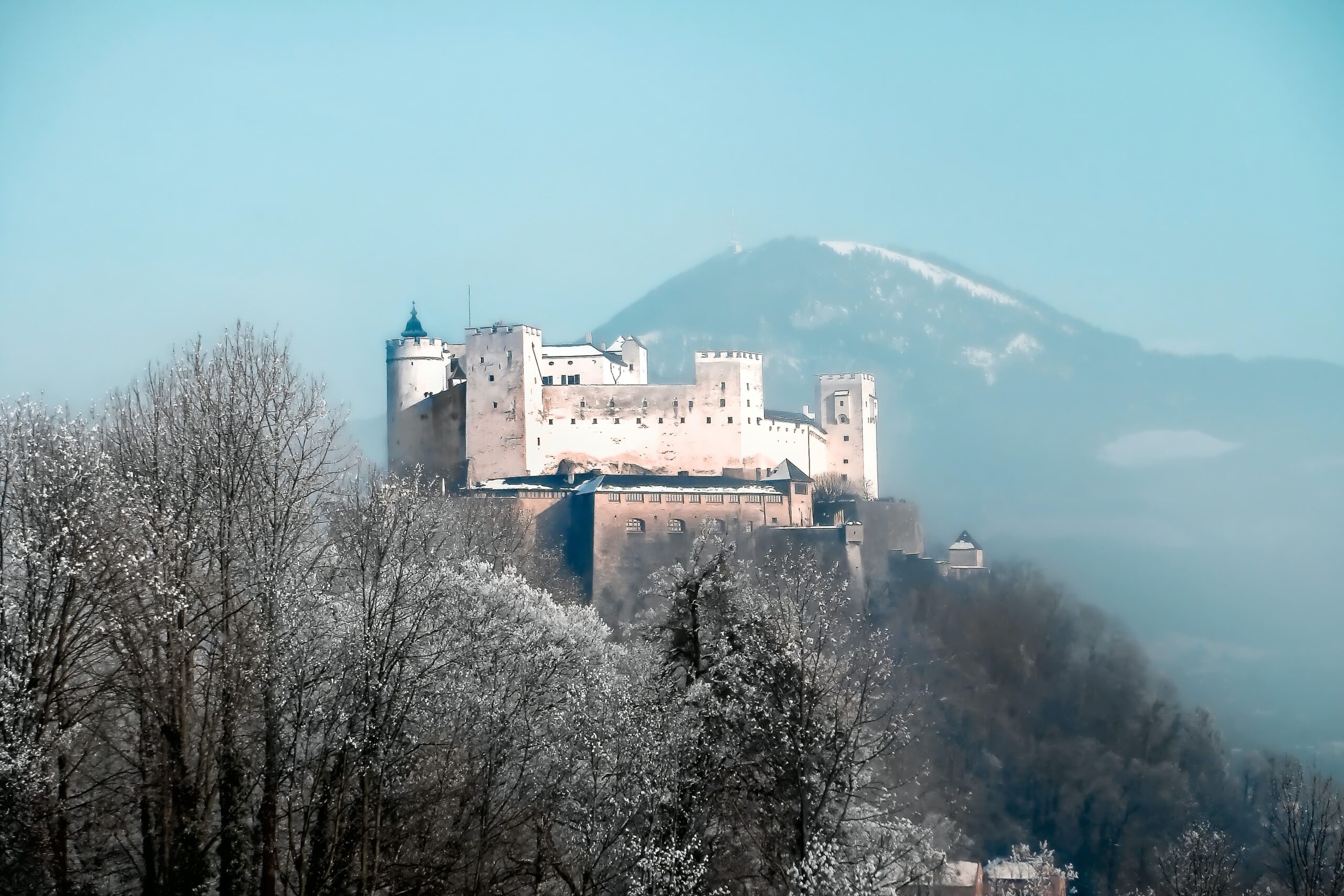

Salzburg Cathedral
Salzburg Cathedral, dedicated to Saint Rupert and Saint Vergilius, is a seventeenth-century Baroque cathedral of the Roman Catholic Archdiocese of Salzburg in the city of Salzburg, Austria. Saint Rupert founded the church on the ruins of a Roman town in 774, and the cathedral was reconstructed following a fire in 1181. Under Prince Bishop Wolf Dietrich von Raitenau in the seventeenth century, the cathedral was entirely renovated in the Baroque style to its current look. The baptismal font where composer Wolfgang Amadeus Mozart was christened may still be found in Salzburg Cathedral.
Melk Abbey
Melk Monastery is a Benedictine abbey located above the town of Melk in Lower Austria, Austria, on a rocky outcrop overlooking the Danube River and adjacent to the Wachau valley. The abbey houses Saint Coloman of Stockerau’s tomb as well as the remains of numerous members of Austria’s first governing dynasty, the House of Babenberg.


Hallstätter See
Hallstätter See, often known as Lake Hallstatt, is a lake in Austria’s Salzkammergut region. It is named after Hallstatt, a tiny market town known for its salt mining since prehistoric times and for being the beginning site of the world’s oldest still-operational industrial pipeline, which transported brine to Bad Ischl and then to Ebensee. Since around 1970/1980, Austria’s sole ship-mail route traversed the lake from the railway on the east bank to the town on the west shore. During the winter, the route on the west coast was frequently obstructed by excessive snow or the threat of avalanches. When the lake’s ice became thick enough, a sled drawn by men or horses, and subsequently a motorized track vehicle, was used to convey mail and people.
7-day Itinerary in Austria (with extension options)
Day 1
Arrive to Vienna
The Austrian capital, located on the banks of the Danube, is regarded as Europe’s cultural center. Imperial palaces, countless balls, and, of course, music can all be found here. You may spend weeks following in the footsteps of musical titans like Mozart, Beethoven, and Schubert, as well as the brilliant Hapsburg emperors and empresses.
You’ll feel as if you’ve gone back in time as you explore everything this magnificent city has to offer.
Depending on when you arrive, you could have time to get acquainted with where you’re staying and the surroundings or even stroll around to places you may want to add in your itinerary.
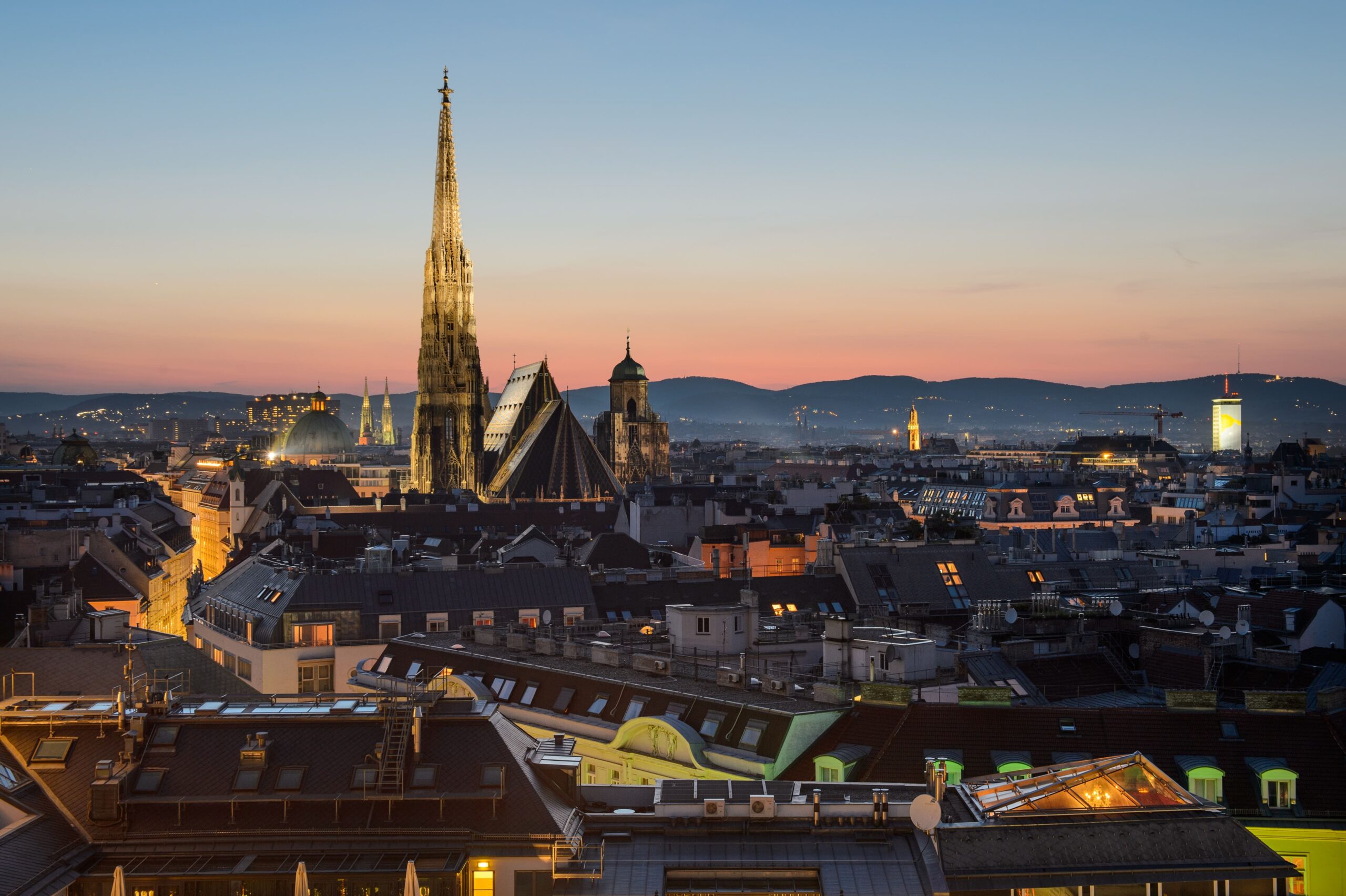
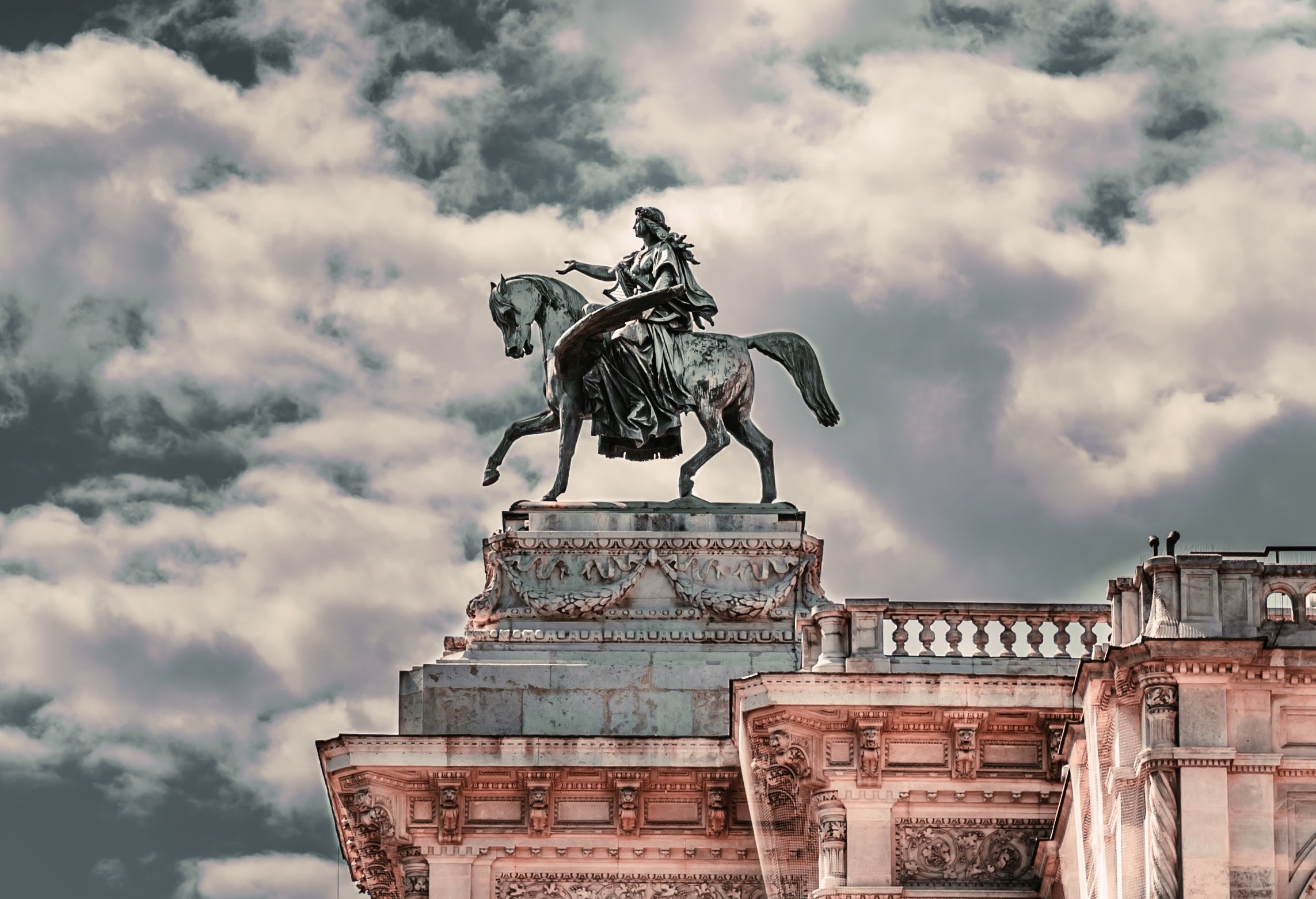
Among the things you could add on this day if you have time to allocate is to go to the shopping districts like the Maria Hilferstrasse street which for decades is the most well-known shopping street in Vienna. Although the dramatic increase in car traffic over the past 40 years has led to a monofunctional, congested, and divided street, there is still a lot to see and do there.
While there you can also go to the Naschmarkt which is Vienna’s most popular open-air market. Located at the Wienzeile over the Wien River, it is about 1.5 kilometers.

- Backpacker:
- Budget:
- Mid-range:
- High end:
This section will be added shortly.
From the Airport to your accommodation
By Train
City Airport Train (CAT)
The CAT will transport you directly from the airport to the city center, with no pauses in between. The train operates from 06:00 to 23:30, with trains leaving the airport every half hour, at 6 and 36 minutes past the hour, and arriving in WIEN MITTE. Follow the green CAT signs after you've collected your baggage. Tickets may be purchased both online and at the CAT port.
Time: 16 minutes
Cost: 11 EUR
S7 Commuter Train
The S7 Schnellbahn, which runs on the same rails as the CAT, takes a few minutes longer and costs a few euros less, but it gets you to the same destination of WIEN MITTE. After you've collected your belongings, look for the Schnellbahn signage (an 'S' in a circle). You may buy tickets from the machines at the top of the escalator and pay with cash or a credit card. You avoid problems on the train, make sure to confirm your ticket when you buy it. Get aboard the train that is heading to 'Floridsdorf.' Trains operate everyday between 04:00 and midnight at 17 and 42 minutes past the hour.
Time: 26 minutes
Cost: 4 EUR
ÖBB Railjet
Railjets travel from the airport to Vienna Main Station or Wein Meidling Station every thirty minutes from 06:33 to 11:03 a.m. every day.
Time: Vienna Main- 15 minutes
Wein Meidling- 30 minutes
Cost: 4.20 EUR
Bus
Vienna Airport Lines
Bus service provided by Vienna Airport Lines is another alternative for airport transportation. It is less expensive than the CAT and faster than the S7. There are three lines that serve various sites across the city. After you've picked up your baggage, look for bus signage. Buses run every 30 minutes between 04:50 and 00:20, leaving every 20 and 50 minutes beyond the hour. Purchase bus tickets from the driver.
Time: 22 minutes
Cost: 8 EUR
Taxi
If you're not on a tight budget, getting a cab from the airport to your destination is the most convenient option. Taxis are queued up just outside the main entrance, just beyond baggage claim. Some cabs take credit cards, but bring cash or euros just in case.
Time: 20 minutes
Cost: 30-40 EUR
Private Airport Transfer
Private airport transport, which costs approximately the same as a taxi, may be a much more pleasant and calm method to go from the airport to the city center. You may pre-book your ride online, and your driver will be waiting for you as you exit the baggage claim area.
Time: 20 minutes
Cost: From 30 EUR
Day 2
Explore Vienna
After breakfast, leave for Vienna’s Hofburg Palace, the winter seat of the Hapsburgs for over 600 years and one of the world’s biggest palace complexes. Tourists may now visit the Sisi Museum, which offers insight into Empress Elisabeth’s convoluted and fascinating life. The Imperial Apartments, which depict Emperor Franz Joseph and his wife Sisi’s daily lives, are also open to the public. The Austrian Federal President’s office has been headquartered in the massive complex since 1946.
After you’ve finished seeing the palace, proceed to St. Stephen’s Cathedral. The tower of St. Stephen’s Cathedral has dominated Vienna’s skyline since its construction. Inside, there are 18 altars, small chapels, burials, and tunnels to see. Climb the 136-meter-high south tower for panoramic views of the city. It takes about 10-15 minutes to mount the 343 stairs.
When you’re done with the cathedral, proceed to the Rathaus, which included five towers, the most impressive of which was the central tower, which was topped by the Rathausman statue. Step inside for a free guided tour at specific times of the week, or visit the museum on a regular basis for a guided tour.


No visit to this city of culture and music would be complete without seeing Vienna’s opera house, which is recognized as one of the greatest in the world, with its Neo-Renaissance style and interior that feels more like a castle than an opera house. A 40-minute guided tour of the building is given during the day. For a more sumptuous evening, attend an opera created by one of Vienna’s musical titans at night.
Your next destination will be Riding the “Giant Ferris Wheel” Weiner Riesenrad in Vienna, which was constructed in 1897. The current Ferris wheel, which stands 65 meters tall, is not the original, yet a ride at sunset is an experience not to be missed. A whole cycle takes around 20 minutes and is a peaceful way to see the attractions of Vienna.




Day 3
Continue Exploring Austria
After breakfast, get an early start and head to the magnificent Schönbrunn Palace, which is located just outside of the city center. Schönbrunn Palace is recognized as one of the most significant historical, cultural, and architectural landmarks in Austria. Empress Maria Theresa built the majority of the 1,441-room Baroque mansion in the mid-1700s. When you’re done exploring inside, proceed to the park, which has been open to the public since 1779. Stroll around the Great Parterre and take in the Crown Prince Garden’s eight sections of well-kept, symmetrical gardens.
You would want to have a snack by now, and no place seems to give a decent Austrian snack better than the Schönbrunn Palace’s Café Residenz’s court bakery, which has been converted into an apple-studded fantasy. You’ll get to take a copy of the recipe home at the conclusion of the tour so you can reproduce it at home!

When you’ve already enjoyed your delicious snack, visit the Natural History Museum in Vienna, which is one of the most important in Europe, with over 30 million items. The museum is set in a magnificent palace complex and has everything for everyone, including enormous dinosaur bones and meteorites, as well as beautiful architecture. If you have time, walk across the street to the Kunsthistoriche Museum, which has paintings, sculptures, and artifacts from the Hapsburg era.
Day 4
Head to Salzburg
Now that you’ve had your fill of Austria’s capital, it’s time to visit “the gem in its crown,” Salzburg.
Mozart, the 18th-century composer, was born in Salzburg, and the city will not let you forget it. The city, whose name translates approximately as “Salt Fortress,” is Austria’s fourth-largest. Churches, castles, and palaces decorate this imaginary metropolis. Maria and the von Trapp Family, made famous by the award-winning film and musical The Sound of Music, were born in Salzburg.
Begin your journey in the Salzburg Fortress. Hohensalzburg is one of Europe’s most intact castles, having never been taken by a foreign army. The magnificent castle atop the Festungsberg has been overseeing Salzburg since the 10th century. The view of the Old Town and the Alps is magnificent. All Fortress funicular tickets include a round-trip ride.


After you’ve finished seeing the Fortress, continue to Mirabell Palace, which is only a 15-minute walk from where the funicular lets you down. The beautifully kept gardens in The Sound of Music may spring to mind. The Pegasus Fountain, entry steps, and circular pond were used for the Do-Re-Mi segment. The palace was finished in 1606 by Wolf Dietrich, the prince-archbishop of Saxony.
You might have observed Altstadt from the stronghold, and this is where you’ll be going next. Take a trip along Getreidgasse, a Medieval retail lane.
Except for the upscale McDonald’s (try to unsee it), you’ll feel like you’ve stepped back in time. Because the city’s population was predominantly illiterate throughout the Middle Ages, these signs aided consumers in discovering competent artists and traders.


The spiritual heart of Salzburg is St. Peter’s Abbey, which was founded in the seventh century. The catacombs, constructed directly into the slope of the Mönchsberg, on which the Salzburg Fortress is located, are a must-see. The cemetery was used as the backdrop for the scene in The Sound of Music in which the von Trapp family runs from the National Socialists.
Hoards of people are drawn to the pergola from The Sound of Music. While this is an excellent reason to visit Hellbrun Palace, the Trick Fountains are also worth seeing. The royal fountains have amused visitors for over 400 years. Water jets, grottos, and water-powered figurines will keep you guessing and wet!
When you’re done take a trip to the famed composer’s birthplace, a must! Mozart’s birthplace is one of Austria’s most popular museums. The museum is well decorated and transports you back to the days of Salzburg’s most renowned citizen.


- Backpacker:
- Budget:
- Mid-range:
- Luxury:
This section will be updated shortly.
From Vienna to Salburg
By Train
The train is by far the most convenient method to get from Vienna to Salzburg. The travel between the cities takes roughly 2 hours and 40 minutes, with trains leaving for Salzburg every hour between 06:00 and 12:00 a.m.
By Car
Renting a car may be the best option if you want to drive out and explore some of the countrysides on your route to Salzburg. Almost the whole travel, the autobahn road runs next to the railway line. Transit time is determined by traffic and weather, however, it is normally less than 3.5 hours.
By Plane
Although there are flights connecting Vienna and Salzburg, flying from one city to the other makes little sense when you can take the train or drive in approximately three hours. Traveling by airline would wind up taking considerably longer and costing much more than required after transit time to the airport, check-in, security, and so on are included in.

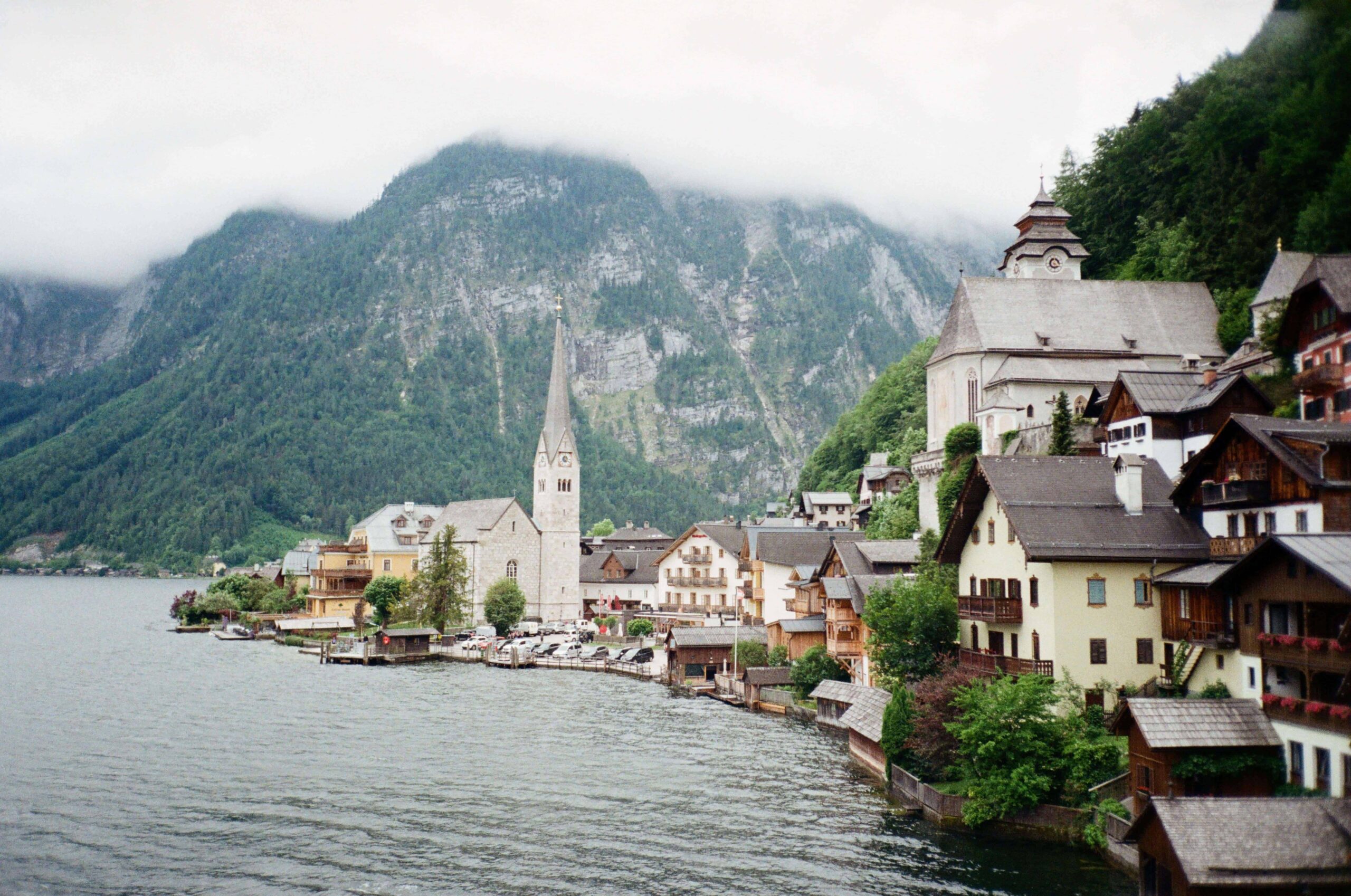
Day 5
A Day Trip to Hallstatt
The journey from Salzburg to Hallstatt is a little difficult logistically, but it is definitely worth it!
This picture-perfect mountain town is one of Europe’s oldest still-inhabited settlements. Hallstatt, which is home to the world’s first salt mine, is today a UNESCO World Heritage site and a popular tourist attraction. Hallstatt is a popular day-trip destination for residents of several nearby metropolitan cities. Day trippers begin to fill the streets about mid-morning, so start your day early if you want to enjoy some peace and quiet!
Begin at one end and work your way to the other. The town is only one kilometer long, so it won’t take you long to get around. There are picture opportunities around every bend. You can obtain the classic, postcard-perfect image of the lake, the church, and the mountains if you go all the way to the north end of the hamlet, at the ferry terminal.

Make your way to the southern end of town and take the funicular to the summit of Salt Mountain for even more breathtaking vistas. Walk out on the free-floating Skywalk around 350 meters just above the town of Hallstatt for an unforgettable World Heritage vista!
When you’re done you may want to visit the main attraction in Hallstatt a 7,000-year-old mine. Hallstatt owes its success and reputation to this ‘white gold,’ and you can witness inside the mine, the history of mining, and the lives of the miners who worked there for yourself. The mine also contains a slide, which is a great method to go from one level to the next.
- Backpacker:
- Budget:
- Mid-range:
- Luxury:
This section will be updated shortly.
By Train
You will have to change trains because there is no direct train from Salzburg to Hallstatt. The train trip takes around two hours and is absolutely beautiful. When you arrive at Hallstatt's main station, you will be on the opposite side of the lake from the town. You'll have to take the boat, which is a good thing. The vistas as you approach Hallstatt from the lake are unsurpassed. The boat leaves every hour and costs €2.50 per person.
By Car
Driving to Hallstatt will take around 1.5 hours. The scenic B158 route via Fuschl, St Wolfgang, Bad Ischl, and Bad Goisern is accessible, as is the highway route via Golling and Gosau on the A10 and B166. The former is more scenic, whilst the latter requires the purchase of an Austrian vignette, sometimes known as a toll sticker.
Alternatively, you can take a tour company-organized day excursion to Hallstatt.
Day 6
A Day Trip to Innsbruck
The trip from Salzburg to Innsbruck is both straightforward and breathtaking, allowing visitors to see many different parts of Austria while admiring the breathtaking landscape along the way.
A visit to the “Alps Capital” is the ideal way to conclude your Austrian itinerary. Innsbruck, located between high, snow-capped mountains along the River Inn, is recognized across the world as a major winter sports destination and a showcase for the Hapsburg Empire’s past. The adaptable city is equally enjoyable to visit in the summer and winter since events abound all year.
Begin your visit to Innsbruck at the ancient town center, Altstadt von Innsbruck. Cafes and restaurants line the old streets, and they’re a fantastic location to sneak inside, warm up for a while, and enjoy a warm apple strudel. Many of Innsbruck’s attractions are located in the Altstadt, so you could easily spend a full day visiting it.
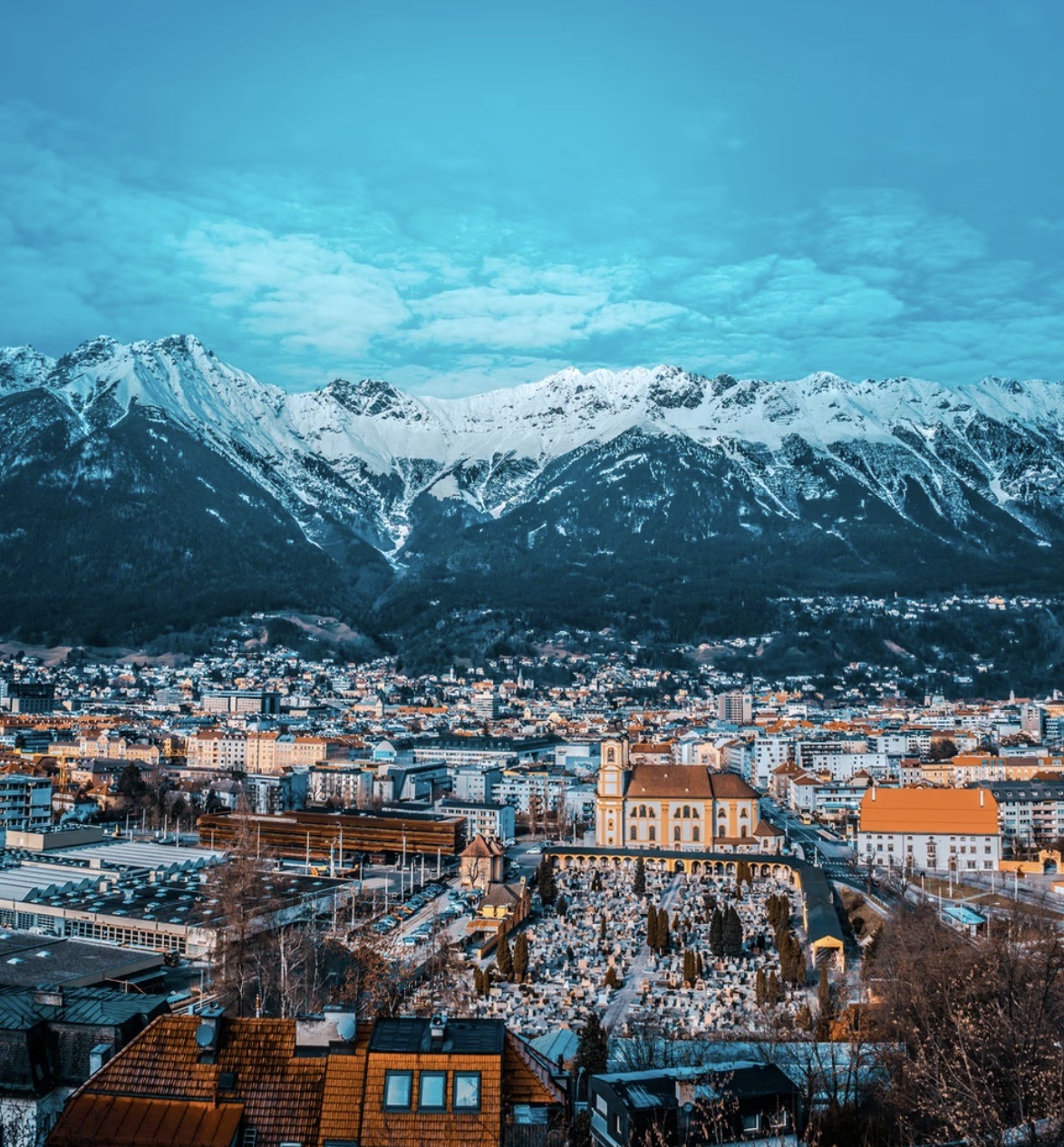

Look no further than the Golden Roof for the type of love that can withstand the test of time. This historic structure was erected in 1500 to commemorate Maximilian I’s marriage to Bianca Maria Sforza. The roof is made up of 2,657 fire-gilded copper tiles and shines brightly when the sun shines on it.
Next up is Hofkirche (Court Church) constructed in 1553. This Gothic chapel, built in remembrance of Emperor Ferdinand I’s grandfather, Emperor Maximilian I, features an empty tomb, or cenotaph, which took more than 80 years to build and is flanked by 28 bronze sculptures.
Afterward, head to The Imperial Palace in Innsbruck is one of Austria’s three most significant historic-cultural sites. Emperor Maximilian I erected the palace in the 15th century, and it underwent substantial modifications in the 18th century. The palace now functions as a museum where visitors may learn about the Hapsburgs’ lavish lifestyle.


Take the Nordkettenbahnen to Innsbruck Congress (560m) and ascend at a 46 percent slope to the Hungerburg (860m). You’ll see the summit cross at the top and be rewarded with 360-degree views that span all the way to Italy in the south and Germany in the north. The cable car will take you to 2256m above sea level from Seegrube.
The Bergisel Ski Jump soars over the city’s southern skyline. During the 1964 and 1976 Winter Olympics, some of the world’s best skiers flew through the air from this famed mountaintop. Take the lift up to the 50-meter-high tower for spectacular views as well as a terrifying descent on skis!
The Four Battles of Bergisel took place on this hill in 1809, when local insurgents attacked Napoleon’s army and Bavarian soldiers. Zeno Diemer’s Tirol Panorama, Tyrol’s largest oil painting, was inspired by the fight. The canvas painting is a 360-degree experience that spans more than 1,000 square meters.

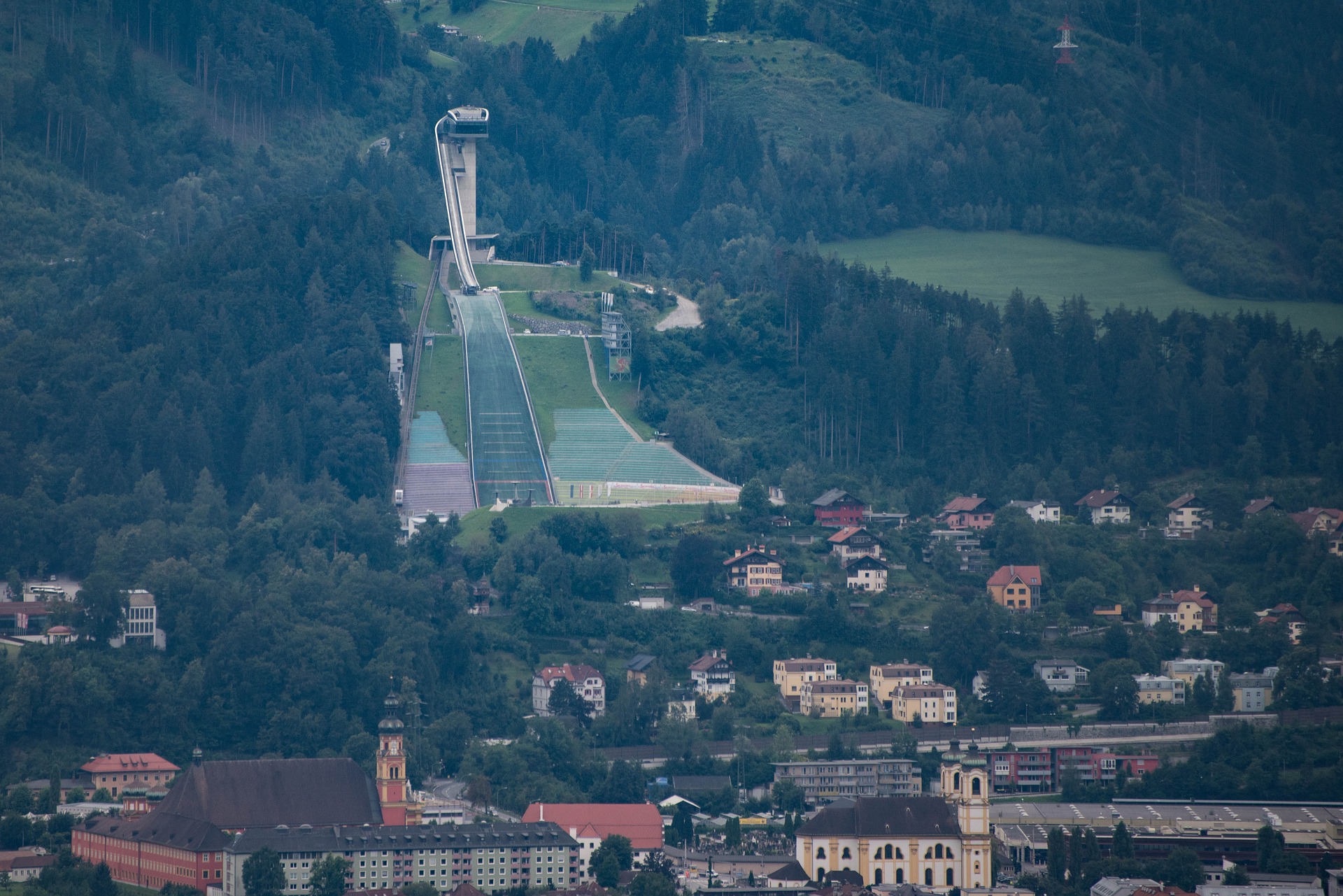
- Backpacker:
- Budget:
- Mid-range:
- Luxury:
This section will be updated shortly.
By Train
Travelers can take a train from Salzburg to Innsbruck which is about a two-hour ride, with one-way tickets beginning at €9. Trains run from around 2.30 a.m. until 10 p.m., so there are lots of possibilities.
By Car
Both Salzburg and Innsbruck have a variety of taxi and rental vehicle options, so this is a practical choice, particularly for families. Renting a private car is also an excellent choice for people who wish to stop en route to photograph the wonderfully picturesque views along the road.
Drivers can choose a variety of routes depending on their time constraints or desire for a picturesque trip. These include traveling through Zell am See, Mittersil, Gerlos Pass, and Ziller Valley, as well as dipping into Germany. If you have an extra 2/3 hours, you may also include the Grossglockner High Alpine Road!

Day 7
Back to Vienna for departure
Hopefully, this thrilling 7-day itinerary in Austria has motivated you to visit this little but formidable nation. You’ll have the opportunity to visit all of the highlights, giving you a taste of everything Austria has to offer while also leaving you with some unknown jewels to add to your future trip.
The Most Popular Food in Austria
Rich tastes characterize authentic Austrian cuisine, which is dominated by meats and carb-dense dishes such as pastries and bread. Austrian food is sometimes confused with Viennese cuisine. Indeed, both have been heavily impacted by the Austro-Hungarian Empire’s territories. Bohemia, Moravia, Hungary, northern Italy, and Croatia, without a doubt, have left their imprint.
There is an Austrian culinary dish for every meal, from crispy Schnitzel to substantial Goulash! If you’re wondering what to eat in Austria, check out all of these delectable Austrian foods that will undoubtedly excite your taste buds and help you get a flavor of Austrian culture.

Wiener Schnitzel
The Wiener Schnitzel is one of Austria’s most famous dishes. It is a breaded beef meal that is fried and frequently served with potatoes. It was traditionally cooked with veal, although today it is more commonly made with pork (You’ve been warned). This dish may be found anywhere from street food carts to high-end restaurants.
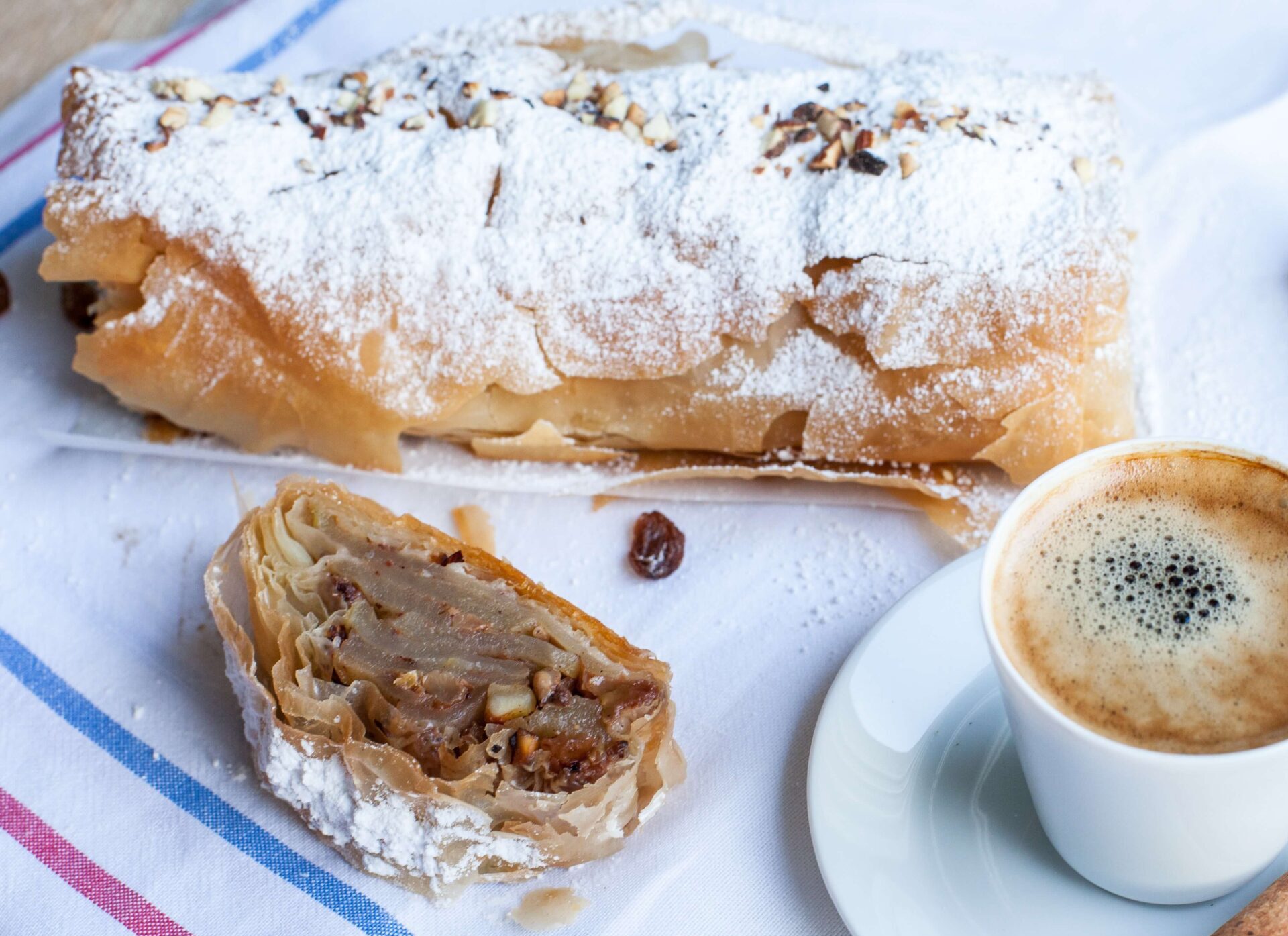
Apfelstrudel
Apple strudel is a classic Austrian pastry delicacy that is filled with apples and topped with powdered sugar and cinnamon. It is frequently served with cream and is a delectable way to end any meal. The aroma of freshly baked Apfelstrudel may make any foodie weak in the knees! The Germans may say that the Strudel is theirs, but Austria has embraced the sweet crusty Apfelstrudel, which is one of their national dishes.
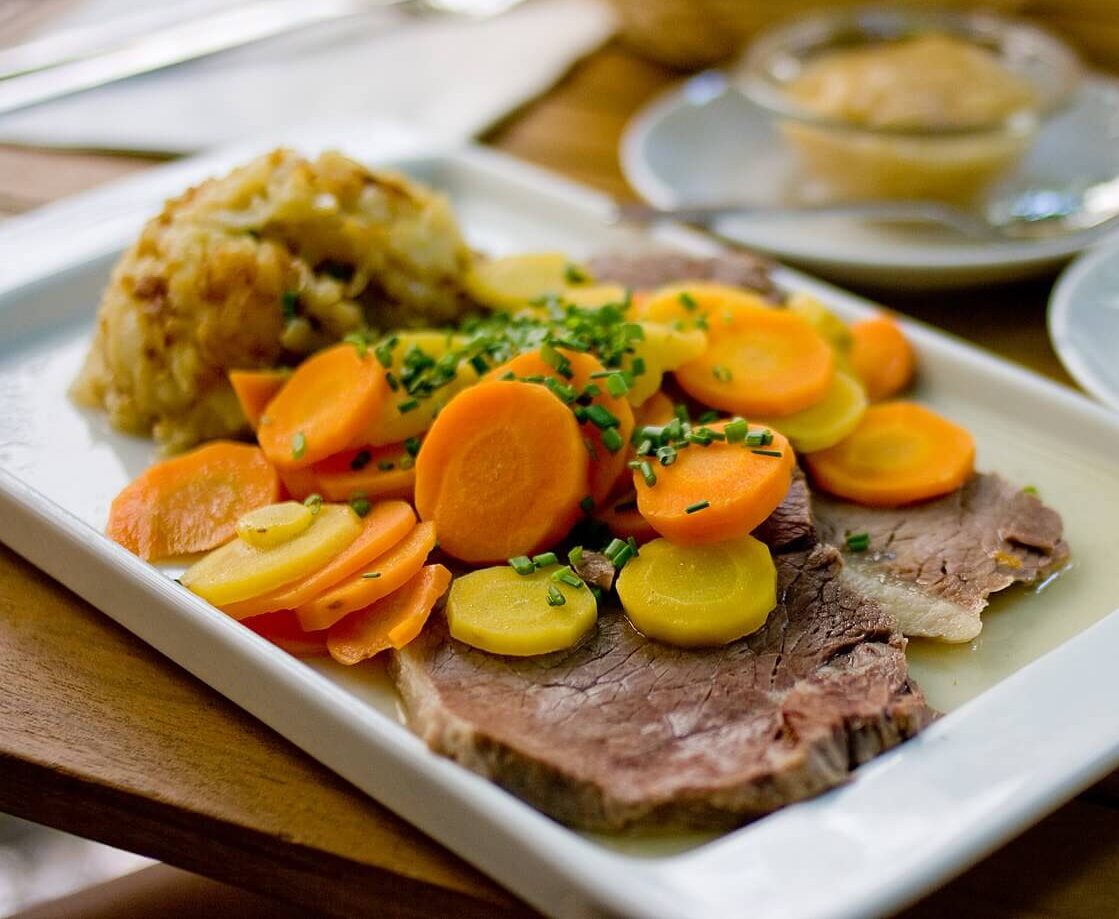
Tafelspitz
Tafelspitz is a spiced boiled beef dish prepared with root vegetables. This is a traditional Austrian main dish served by many restaurants across the country . The meat is normally cooked for a long time with the veggies. The dinner is completed with a sauce of minced apple, horseradish, and sour cream. It’s a traditional meal that consists of beef simmered in a broth of veggies and spices.

Gulasch
Gulasch is a hot soupy stew that comes in a variety of variations, as soups normally do. It’s made with potatoes, onions, bell peppers, and sausages, and it’s seasoned with fiery paprika. A bowl of Gulasch finest served with buttered bread and serves as the best Austrian breakfast. Although originated from Hungary, the hearty and spicy Gulasch has long been a staple of Austrian cuisine.

Tiroler Gröstl
The Tiroler Gröstl, the epitome of comfort food! is one of the most popular traditional Austrian foods in Vienna, although it is more popular in the Austrian Alps. The dish is a pan-fried dish of potato, chopped beef or pork, and loads of butter and onion. It’s a must-try for anybody who like traditional Austrian fare, and it’s frequently topped with a fried egg.
What's the Travel Budget for Austria?
Flights
- Flights start at roughly $120 from nearby countries. Tickets however on average cost around $700 and can cost more depending on which class and from which country you depart from.
Accommodation
- Nomad Backpacking style travelers can expect to spend around $400 for a week
- Budget travelers can expect to spend around $600 for a week
- Mid-range travelers can expect to spend around $900 for a week
- Luxury travelers can expect to spend around $3000 for a week
Food Budget (Three meals and drinks)
- Nomad Backpacking style travelers can expect to spend around $20 per person per day
- Budget travelers can expect to pay around $35 per person per day
- Mid-range travelers on average would cost $50 to $60 per person per day
- Luxury travelers can expect to pay around $100 to $130 per person per day
Overall Budget Styles (Not including Flights, Tours, Transportation, or Car Rental)
- Nomad Backpacking style travelers can expect to spend around $600 for a week
- Budget travelers can expect to spend around $900 for one person for a week
- Mid-range travelers can expect to spend around $1400 for one person for a week
- Luxury travelers can expect to spend around $4000 for one person for a week
Flights
- Flights start at roughly $120 from nearby countries. Tickets however on average cost around $700 and can cost more depending on which class and from which country you depart from.
Accommodation
- Nomad Backpacking style travelers can expect to spend around $400 for a week
- Budget travelers can expect to spend around $600 for a week
- Mid-range travelers can expect to spend around $900 for a week
- Luxury travelers can expect to spend around $3000 for a week
Food Budget (Three meals and drinks)
- Nomad Backpacking style travelers can expect to spend around $20 per person per day
- Budget travelers can expect to pay around $35 per person per day
- Mid-range travelers on average would cost $50 to $60 per person per day
- Luxury travelers can expect to pay around $100 to $130 per person per day
Overall Budget Styles (Not including Flights, Tours, Transportation, or Car Rental)
- Nomad Backpacking style travelers can expect to spend around $600 for a week
- Budget travelers can expect to spend around $900 for one person for a week
- Mid-range travelers can expect to spend around $1400 for one person for a week
- Luxury travelers can expect to spend around $4000 for one person for a week
Flights
- Flights start at roughly $120 from nearby countries. Tickets however on average cost around $700 and can cost more depending on which class and from which country you depart from.
Accommodation
- Nomad Backpacking style travelers can expect to spend around $400 for a week
- Budget travelers can expect to spend around $600 for a week
- Mid-range travelers can expect to spend around $900 for a week
- Luxury travelers can expect to spend around $3000 for a week
Food Budget (Three meals and drinks)
- Nomad Backpacking style travelers can expect to spend around $20 per person per day
- Budget travelers can expect to pay around $35 per person per day
- Mid-range travelers on average would cost $50 to $60 per person per day
- Luxury travelers can expect to pay around $100 to $130 per person per day
Overall Budget Styles (Not including Flights, Tours, Transportation, or Car Rental)
- Nomad Backpacking style travelers can expect to spend around $600 for a week
- Budget travelers can expect to spend around $900 for one person for a week
- Mid-range travelers can expect to spend around $1400 for one person for a week
- Luxury travelers can expect to spend around $4000 for one person for a week
Flights
- Flights start at roughly $120 from nearby countries. Tickets however on average cost around $700 and can cost more depending on which class and from which country you depart from.
Accommodation
- Nomad Backpacking style travelers can expect to spend around $400 for a week
- Budget travelers can expect to spend around $600 for a week
- Mid-range travelers can expect to spend around $900 for a week
- Luxury travelers can expect to spend around $3000 for a week
Food Budget (Three meals and drinks)
- Nomad Backpacking style travelers can expect to spend around $20 per person per day
- Budget travelers can expect to pay around $35 per person per day
- Mid-range travelers on average would cost $50 to $60 per person per day
- Luxury travelers can expect to pay around $100 to $130 per person per day
Overall Budget Styles (Not including Flights, Tours, Transportation, or Car Rental)
- Nomad Backpacking style travelers can expect to spend around $600 for a week
- Budget travelers can expect to spend around $900 for one person for a week
- Mid-range travelers can expect to spend around $1400 for one person for a week
- Luxury travelers can expect to spend around $4000 for one person for a week
If you want to know what to pack, read this list below:
- This is a casual country that can get extremely cold, dress accordingly
- Raincoat or Light Waterproof Jacket
- Hiking Boots or Sturdy Sneakers (Shoes You Don’t Mind Getting Wet)
- Sunscreen
- Insect Protection – Repellent and Clothing
- Sunglasses and Sun Hat
- Water Shoes
- Beach Towels/Sarong
- Dry Bag
- Money Belt or Cross Bag
- Portable Medical Kit
- Flashlight or Headlamp
- Copies of your passport.
- Get all the needed vaccinations before traveling
- A power bank is a must in any travel.
- Always have some cash with you just in case there are no ATMs and if you are dealing with a business that solely accepts cash
- Get yourself an adapter for your gadgets
- 1 toothbrush
- 1 tube of toothpaste
- 1 razor
- 1 package of dental floss
- 1 small bottle of shampoo
- 1 small bottle of shower gel
- 1 towel
- Deodorant
- Band-Aids
- Hydrocortisone cream
- Antibacterial cream
- Earplugs
- Tylenol
- Hand sanitizer (germs = sick = bad holiday)
- A key or combination lock
- Zip-lock bags
- Plastic bags (great for laundry)
- Universal charger/adaptor
- LifeStraw (A water bottle with a purifier)
- 1 dry shampoo spray & talc powder
- 1 hairbrush
- Makeup you use
- Hairbands & hair clips
- Feminine hygiene products
Clothing For Boys
- 1 pair of jeans or khaki pants
- 1 pair of shorts
- 1 bathing suit
- 5 T-shirts
- 1 long-sleeved T-shirt
- 1 pair of flip-flops
- 1 pair of sneakers
- 6 pairs of socks
- 5 pairs of boxer shorts
Clothing For Girls
- 1 swimsuit
- 1 sarong
- 1 pair of stretchy jeans
- 1 pair of leggings
- 2-3 long-sleeve tops
- 2-3 T-shirts
- 3-4 spaghetti tops
- 1 light cardigan
Want to plan your own trip, here are some of the best resources that can help you
- Skyscanner – They search small websites and budget airlines that larger search sites tend to miss. They are hands down the number one place to start.
- Momondo – This is another favorite flight search engine because they search such a wide variety of sites and airlines. Always check here too.
- Booking.com – The best all-around booking site that constantly provides the most affordable and lowest rates. They have the widest selection of budget accommodation.
- Couchsurfing – This website allows you to stay on people’s couches or spare rooms for free. It’s a great way to save money while meeting locals who can tell you the ins and outs of their city. The site also lists events you can attend to meet people (even if you’re not staying with someone).
- Intrepid Travel – If you want to do group tours, go with Intrepid. They offer good small group tours that use local operators and leave a small environmental footprint.
- Grassroots Volunteering – For volunteering, Grassroots Volunteering compiles a list of good local volunteer organizations that keep the money within the community.
- Get Your Guide – Get Your Guide is a huge online marketplace for tours and excursions. They have tons of tour options available in cities all around the world, including everything from cooking classes, walking tours, street art lessons, and more! It has the world’s largest collection of things to do with more than 30,000 activities in 7500 destinations.
- SafetyWing – Safety Wing offers convenient and affordable plans tailored to digital nomads and long-term travelers. They have cheap monthly plans, great customer service, and an easy-to-use claims process that makes it perfect for those on the road.
- Trip Advisor: Check the reviews and then book your accommodation. TripAdvisor is where you go when you want to compare prices with multiple accommodation providers.
- VRBO: is the main search engine to use when you are looking for a home or apartment rental. It can sometimes be cheaper than hotels and it is the best way to stay in areas that offer a more local feel.
- Hostelworld: With one of the largest databases of hostels in the world, Hostelworld is the go-to site when you are looking for budget accommodation.
- Rome 2 Rio: If you want to see how to get somewhere by plane, train, bus, ferry, or car Rome2Rio lays it all out for you as well as related costs.
- World Nomads Insurance: When traveling you should always have travel insurance. We have found the best bang for your buck is by far World Nomads.
Final Thoughts on Austria
Austria’s former empire has its roots in everything around the country, making it a vibrant, and beautiful land that is worth traveling to. From breathtaking natural beauty to man-made wonders of art and architecture. Another advantage of this European gem is that it changes dramatically from season to season; you might return year after year to see the changing scenery and diverse activities on offer! Would you?
If you’ve been to Austria let us know how your trip was in the comments below.